Back to Sidestreet Bannerworks
Click here to find out how your engine can be featured!
.

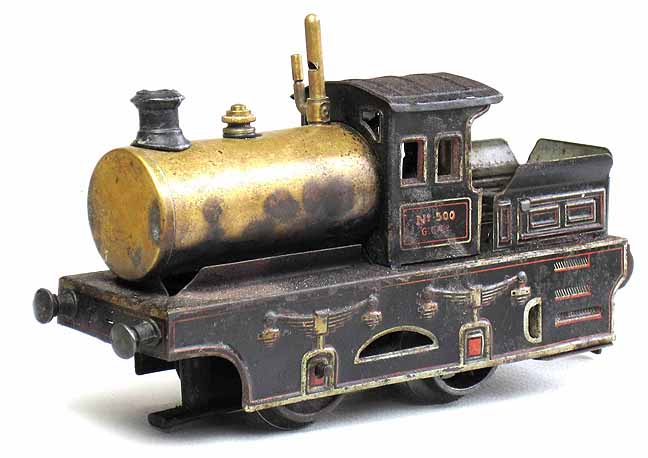
A geared Carette 0-4-0
by Grant Fehr
Peyton Colony, Texas
Photos by the author
August, 2012
You are not likely to find the word Kraftlokomotive (or Kraftlok) in a German dictionary, even in a very thick lexicon of technical German. But that is what this loco is. Kraft means "power," "energy," "strength," etc., and Kraftlok is sometimes applied endearingly to small, workhorse locos. However the word really comes from the book of toys and today it is appropriate to call any single-cylinder toy steam loco a Kraftlok.
Gebrüder Bing of Nürnberg was among the first to use the term at the beginning of the 20th century. In its British catalogues, the term was rather clumsily translated as "force locomotive” and was applied to its tiniest single-cylinder steam models, as if to reassure that these really were a going thing. But Ernst Plank, another early Nürnberg toymaker who may have supplied Bing, was likely the originator of the Kraftlok. His catalogues asserted an explicit definition, noting that twin-cylinder locos require more steam, thus more fire, but a single cylinder gets the job done for less through a geared drive. “Thus the performance of these locomotives is increased very significantly and the speed is controlled so that a derailment is entirely excluded".
Georges Carette & Co., another Bing Brothers supplier and later competitor, also produced little single-cylinder locos with a hint of whimsy and style usual to Carette, though to some tastes the example at hand may run short of that ambition. This model was clearly an attempt to compete in the British market with Bing's cheapest “force locomotive” -- with little success, judging from its rarity today. Nevertheless its natty lithography will not be found on any old Bing.
Carette numbered its steam locos in the 500 range, and the "No. 500" above the "G.C.Co" on the cab side suggests that this example was the first of the series. However, in Carette's 1911 British catalogue, this exact loco (including the “No. 500”) was illustrated as model 501/35, whereas model 500/35 was identical but minus the whistle (and thus slightly cheaper). The “35” of course is the early measurement in millimeters (between the rail centers) for today's 0 gauge.
Nine years earlier (in 1902), Bassett-Lowke had catalogued three Carette “stork legs” (with twin outboard oscillating cylinders) numbered 503, 504, and 505, and Gamage's had shown the 504 and also the 502, a very small stork leg. Yet models 500 and 501 were absent, though, logically, they also must have existed then, and even before.
I have included a photo from a German forum that shows a Carette loco as found in its original plain box. The end of the box is stamped “No. 501/48,” identifying the contents as a (Carette) model 501 in gauge 1. This is an example of the German-market Carette Kraftlok, made in both “35mm” and “48mm” gauges from about 1900 right up until WWI. Like mine, it's a “501” because it has a whistle. Also, like mine, it has a single vertical cylinder in the cab driving a flywheel. But the chimney is of the German style, the chassis is oddly attenuated, and the fuel tank (with three burners) is an exposed afterthought under the long "bunker".
Another photo shows two early loco toys by another Nürnberger, Johann Leonard Hess. One is clockwork. The other has "friction" or "roller" drive, whereby a lead flywheel is spun with the fingers or a length of string spooled around the axis. The weight of the flywheel bearing on the rims of the drive wheels makes the thing go. Hess produced variants of this outline in quantities approaching infinity, with and without drive mechanisms. They were offered by numerous distributors, including Gebrüder Bing and Georges Carette & Co.
It's no stretch to see the similarities between these Hess toys and the Carette “German” Kraftlok -- and, by extrapolation, my loco and its Bing contemporary. The clockwork Hess has a short "Brit" chimney and its "bunker" becomes a "tender," thanks to those dinky little wheels. But the only real difference in outline is that, whilst Hesses are floor runners, Kraftloks needed to fit a very tight oval or circle of track. A compact 0-4-0 arrangement was the solution.
Nor does the resemblance stop there. While the power transfer in my British-market 501/35 is two spur gears, its German cousin relies on the friction method. That is, the very stout axle ends supporting the flywheel and crank rest directly on the drive-wheel flanges.
Utterly simple. . .or crude. And certainly cheap enough. But by looking and working like an infant's toy, it likely failed to interest proper British retailers of “model” steam locos. I desperately want one.
Which is not to say I am disappointed with my little 501. Its outline may be generic at best but its stumpy aplomb says, “I am what I am.” By happenstance, it came to me from Camborne, in Cornwall, not twenty-five miles shy of Land's End. At the peak of Cornish tin mining, Camborne was its center -- a significant source of tin and tinplate for the Nürnberg toy industry. And, just to deepen the trivia, it was on Christmas Eve of 1801 that Robert Trevithick, the son of a miner, with his partner Andrew Vivian and a few of their pals, drove the "first steam-powered passenger-carrying convenience" through Camborne Cross and up the hill and about. Stephen Williams, a passenger, later recalled that "an old lady named Paull cried out 'Good gracious, Mr. Vivian, what will be done next? I can't compare un to anything but a walking puffin' devil.'" And "Puffing Devil" is how that monstrous plaything is remembered in Camborne today. Thus, I call this tiny fellow Cornishman of Bavarian birth Der Paffend Teufel.
The model
As received, it was in pretty good state. Only one tab of four is left for the roof. The port side has got the worst from damp storage and the brass must settle for what little polish I can offer. But the solder is all sound and the main thing was resurfacing the cylinder and port blocks to mate like two mirrors. After that, Der Paffend Teufel's first steam-up on the bench was just about faultless.
The fuel tank clips into the bodywork. The filler hole is shaped conveniently like a funnel-in-place. The cork stopper is not original but correct. I've left the wicks in as-found condition; I'm not sure if they are asbestos but they reliably produce a hot, steady flame.
The steam line pokes right out of the backhead to the block, meaning a nominal 60 ml. boiler is really about 45 ml., if you want steam. The exhaust puffs like der Teufel, straight into the cab for the benefit of the rust. But, compared to what Bing was making in the same range, the construction is quite robust, if otherwise tabbed together like any tinplate toy. Likewise, the entire drive mechanism is a single module, with a stout, steel frame tabbed into the lighter bodywork. The crank is also steel but, as in Bing's models, the flywheel and drive wheels are lead and reportedly susceptible to melting in derailment fires, despite Plank's “exclusion.”
Plank was more on the mark about the velocity. Der Teufel's brass flywheel pinion has ten teeth, while the steel axle gear has fifty-two, yielding a dawdling pace but stubborn Kraft where wheel meets rail, like a one-armed Shay. Its twenty-nine meters per minute on my railway is two-thirds the rate of its Bing competitors, although the engines of both makes oscillate in the vicinity of seventeen to eighteen hundred strokes per minute.
Coaches are of a stamping identical to what Carette advertised with several of its cheapest clockwork sets. They also appeared in a little Hochbahn (elevated railway) set by Karl Bub (Nürnberg) as early as 1908. But their type is often attributed to J. A. Issmayer of Nürnberg, even if the subdued lithography of these two is not typical of that maker. As is, they reckon themselves rather grand in such diabolical service.
Here is a video of the engine being bench-tested. If, for some reason, you can't see it, click here.
And here's a movie of it running on the author's railway with its train of coaches. Click here if you can't see it.
|
|
|
| Builder | Georges Carette & Co. (Nürnberg, Bavaria) |
| Date completed | c. 1911 |
| Gauge | 0 (32mm) |
| Tank capacity | 20 ml. (including burner tubes) |
| Boiler | Pot |
| Fittings | Safety valve, whistle |
| Fuel | Alcohol |
| Cylinders | One oscillating vertically, driving crankshaft with flywheel |
| Reversing gear | None |
| Lubricator | None |
| Power transfer | Crankshaft pinion to axle spur (ratio 5.2 : 1) |
| Dimensions | Length, 170 mm; width, 48 mm; height, 105 mm. |
| Weight | 295g (dry) |
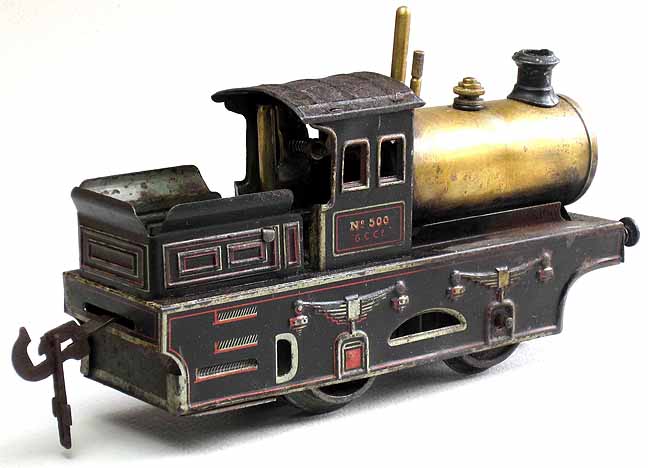
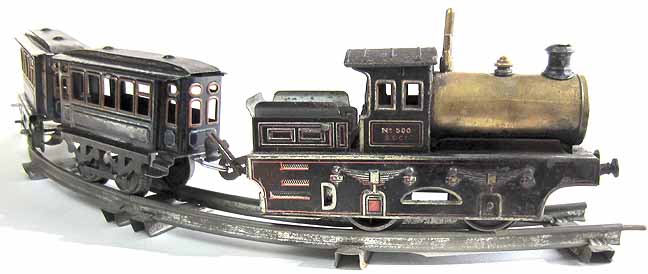
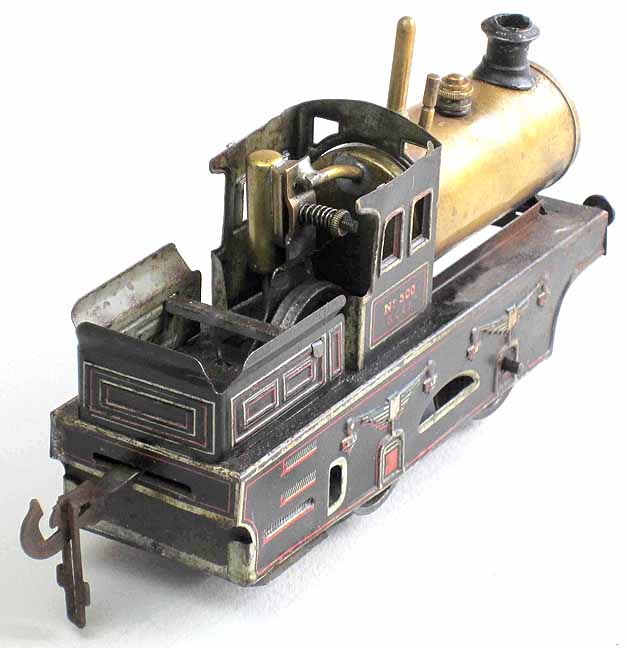
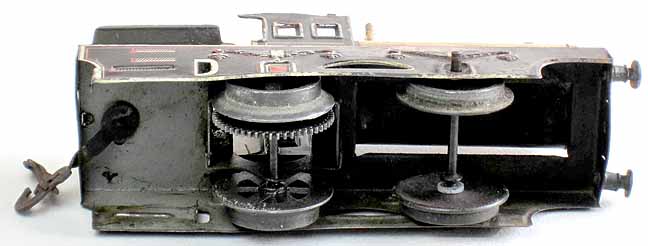
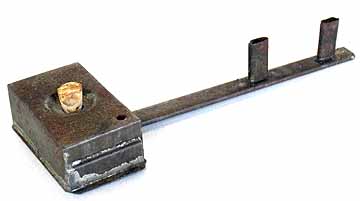


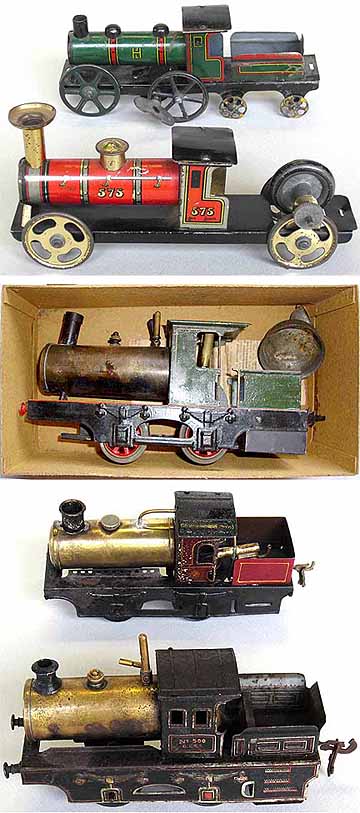
Top right: A pair of floor locomotives by Johann Leonard Hess. The one in the rear is clockwork. The one in the foreground has what's known as a friction drive. Energy is stored in the flywheel, which is then transmitted to the wheels by the flywheel's axle, which rests directly on the rear wheel. Some early steam locomotives used a similar device.
Middle right: A Carette No. 501 gauge-1 loco in its original plain box. This is an example of the German-market Carette Kraftlok, made in both “35mm” and “48mm” gauges. The “501” designation indicates that it has a whistle.
Bottom right: The author's engine (foreground), as compared with a similar locomotive made by Bing. The Bing's cylinder is mounted horizontally whereas the Carette's is vertical.
Back to Sidestreet Bannerworks
Click here to find out how your engine can be featured!
This page and its contents
Copyright Sidestreet Bannerworks, 2012